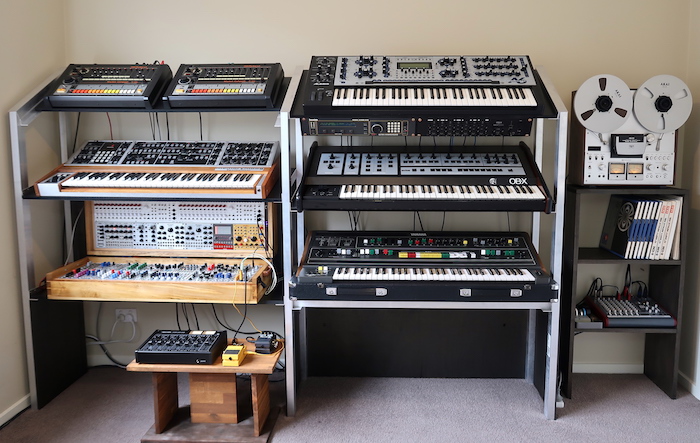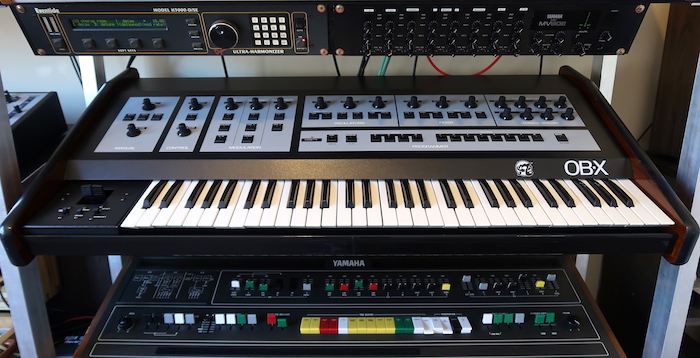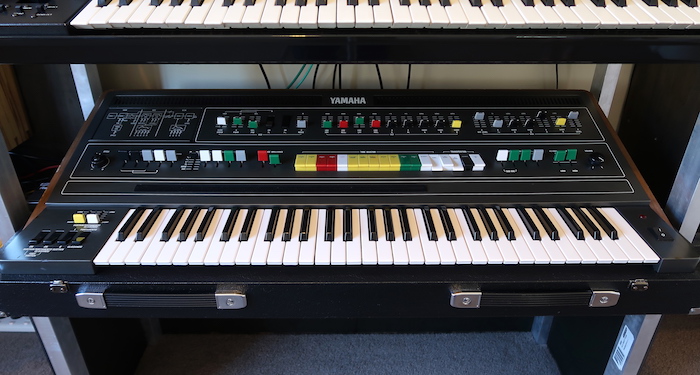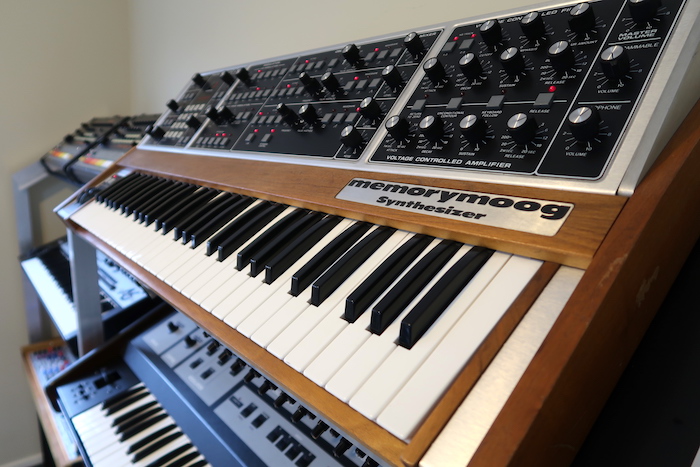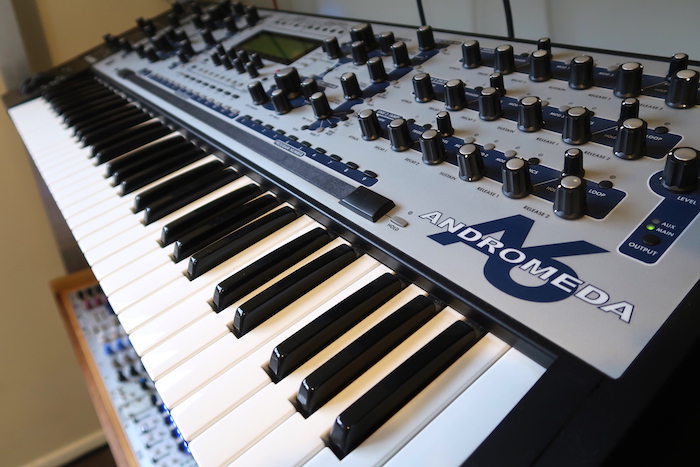GOLT !
My Synthesizers
Like most synth enthusiasts my goal is to own all my "dream synths". In that respect I'm lucky because I don't change my mind much. Also if a synth is stored away for ages and not used I'll generally sell it. I think it's better to have the money in reserve and ready to go in case one of my favourites pops up. A lot of the synths I like only come up for sale once every year or so! One good thing about that is it stops me from impulse buying every new synth that comes out, only to realise that they weren't that great. I've been there, done that. Especially with VA's. Consequently I am extremely happy with everything I have at the moment.
I'm still building stands for most of them. I'm trying to maximise the space I have because I am only in a small room.
Here is a list of my favourite synths of which I still own. I have others, but these are the highlights in my opinion.
My Current Synths
OBERHEIM OB-X
Build Date: August 1979
Revision: Rev 1. There were actually at least 6 or 7 revisions in the OB-X's short life. Some revisions lasting less than 100 synths before the next version. In reality, Oberheim were constantly updating the OB-X so it can be difficult to tell between versions, especially without opening them up. Because of difficulty in telling them apart, most synth enthusiasts just divide the OB-X into two revisions, a first and a second. With the difference being the where the "OB-X" is positioned on the top panel (first on the bottom right, near the keyboard; second on the top left). There weren't any changes that effected the sound so it doesn't really matter anyway. So I a use the simple method of telling them apart, making mine a Rev1.
MY THOUGHTS
Once upon a time, synths were allowed be really really good at one thing only. They didn't need to do everything. That's why you bought more than one synth. These days each new synth seems to be able to do almost everything mostly well. Which begs the question: Why do you need ten synths that can all do a little bit of everything? Well, the OB-X can't do everything. But what it does is astonishing. Pads. Fat. Thick. Rich. Pads. And a sweet spot that's as big as the synth itself. It's like the pots won't let you adjust it outside of it's sweet spot. It ALWAYS sounds good. ALWAYS.
A few times I've heard it described as the "savage" of the OB series, although I'm not entirely sure it fits that description. Certainly the oscillators have a bite to them that only 70's synths seem to have. They definitely don't have that high end refined fizz that the CEM3340 based synths do (like the OB-Xa, OB-8, Memorymoog, Prophet Rev3 etc). But what you get in return is a much more powerful low end, that seems to vibrate and growl with much more authority. It is easily the best sounding synth I have ever heard. My expectations where high and it smashed them out of the park.
It's relationship to other OB synth's is kind of like comparing early Prophet's to the CEM based Prophet's, early Minimoog's to the later Minimoog's, or the Jupiter 4 to the rest of the Jupiters. It's more agressive than it's younger siblings. More profound, raw, bold... But quite obviously from the same family. Something inherently unstable lies inside this synth, and the result is beyond fat. And that filter is so rich and creamy, with such a powerful resonance, it smooths off the discrete oscillators with class; typical vintage SEM.
In fact the voice cards have the same circuit (in the audio path) as the original SEM modules; it's just that the High Pass and Band Pass filter outputs were not tapped off in the X. All filter outputs are still right there on the voice boards but only the Low Pass was connected. This is what you get when you put 8 vintage SEM modules in a box and give them one set of common controls. They are only JUST able to work together and the result is to die for. It's also more versatile than you think. But I agree that it is just so good at pads, there is almost no point using it for anything else. It's Ferrari of pad synths and I treat it as such.
When I was making an exact copy of the voice card, I often used the SEM schematics to help confirm resistor values in the OB-X. The X schematics were hard to read in places, so I used the SEM to help me work them out, and then verified by testing on the actual OB-X cards. The only difference between the OB-X and SEM voicing circuits is the envelope generator (a non-audio element) and I really like the one in the OB-X. The envelope times are just perfect.
The OB-Xa might be the most common and famous OB, but the X is in a class of it's own. Truely an end of an era. Oberheims became generally full of CEM chips after this. Which wasn't necessarily a bad thing. But they did sound different.
I still can't believe I own one. Whatever you've heard about the OB-X... "it's true, all of it".
YAMAHA CS-60
Build Date: Early 1978
Revision: There weren't really different revisions. Mine was made about 6 months after the oscillator tuning update started being applied at the factory and sometime before the mains switch was changed to the newer type (mine originally had the cream coloured ON switch but I changed it to black).
MY THOUGHTS
The classic long term relationship. The more you put in, the more you get out. Initially the controls appear to not repsond how you expect. When you first sit down in front of one it may take some time to pull some really great sounds out of it. You need to get to know it intimately first. But when all the pieces of Yamaha's weird synthesis puzzle finally fall into place, it became for me, the most rewarding synth out of any that I have ever owned. It's the synth I turn on first. The synth I write music on. The synth I use when I'm just bored and have nothing else to do.
The filter section in particular deserves a mention. The two filters (one 12dB HP and one 12dB LP) are in series like on the Korg MS-20, but not only can they be adjusted separately and used at the same time, they can also be linked. Once you set the cutoffs and resonances relative to each other using the sliders, you can then use the paddles below to change the cutoff and resonance of both filters at the same time. So you can set the two filters relationship to each other, and then move both while maintaining that relationship. This means single and dual peak bandpass filters are possible, with adjustable resonances for each peak.
The keyboard is unbelievably expressive for a unit with only single channel touch response. The keybeds unique displacement sensitivity (how far the key moves) is most impressive. Velocity and aftertouch are actually combined and the transition between the two is seamless and natural.
This is a highly responsive synth, with a wonderful ribbon controller and even more wonderful ring modulator. It's unquestionably capable of emotive sequences, with even the smallest changes to patches or playing style making big differences to the result. It tracks really well. It's extremely stable. And contrary to popular belief, it has two of the most resonant filters I have ever heard. It's not a steep filter slope, sure, far from it (sounds even less steep than 12dB, like 10dB) and it doesn't self-resonate, but don't confuse that with resonant power. The resonance peak is massive, to the point where you nearly can't overlay the two filters at full resonance. Even one filter is enough distort the VCA if the filter hits the same frequency as the oscillator. It may not be the best at thick pads, but it is a fantastic lead synth (yes Vangelis) and tremendous at evolving ambient sounds. And without question, by far the most enjoyable synth to play, out of all the synths I own.
I don't think you will really understand unless you own one. Some people will just never get past the fact that it has a single oscillator per voice. Well, so does the Jupiter 4. This synth is for synth lovers, not haters. I can't imagine being without it.
When musicians visit to drop off their synths for repair, they always stop and have a play. The CS-60 is always the one that produces the "wow's". It's nice to know that full time musicians are as impressed by this synth as I am. Don't be blinded by the CS-80, the CS-50 and CS-60 are great in their own right.
MOOG Memorymoog
Build Date: Mostly likely '84
Revision: Very late, just before the Plus came out. It has the Rev 2.5 firmware which is really high for a MM.
MY THOUGHTS
Just brilliant. It's SO bold. I call it the "fuck you" synth. It's the synth you would make if you were giving the middle finger to the rest of the synth world. Just imagine every (good and bad) trait of an analogue synth, then push it to the extreme. If three analogue oscillators per voice aren't enough (with ALL waveshapes simultaneously available from each), the audio levels of the oscillators are so high that they basically smash into the mixer section and instantly overdrive, producing rich harmonics. On mine, the safe (non-overdriven) zone for oscillator volume is about 2/10. Yep 2 out of 10. Any higher and you start to slightly overdrive the oscillators into the filter. By about 4/10 you are running hot into filter and starting to overdrive in the mixer itself. By 8/10 you are waveshaping into zones traditionally only reserved for modular synths. And if you think I don't use it at 10, you're mistaken :-D
You might think that this "drive" limits the potential of the synth to make complex and pleasing soft sounds. It doesn't. You can turn the oscillators down. Yes - it is possible to use a knob on a low setting. You turn it anti-clockwise and leave it there. I know this goes against convention where everything is turned up to 10 by default. But this synth teaches you to be gentle.
As far as sounds go, it's the liveliness that is so striking. With the oscillator mixer knobs set at about half way, as the three oscillators interfere with each other, you get these really pleasing transient distortions. I think they happen when the waves briefly reinforce each other and pop up into the zone where they get VERY briefly overdriven by the mixer. Like micro-transient overdriving. It's continually occurring (smoothly) and sounds random. It wouldn't surprise me if there were other processes contributing as well. There's a micro-tonal instability about it which is just so rich. It really is an amazing synth. Totally different to just stacking six minimoogs in a box. Not to mention the modulation is much more advanced than the mini, with more LFO's and more routing options. The filters are classic moog, and even though the oscillators are not discrete, this is the best use of the CEM3340 VCO chip to date. It's a wonderfully complex and rewarding synth that deserves the high price tag.
ALESIS ANDROMEDA A6
Build Date: 2005
Revision: Mid-Production
MY THOUGHTS
Unison. If there is one sound that defines this synth more than any other it's the high end fizz of the oscillators in unison mode. It's probably my favourite unison sound on any synth. Early firmware versions only allowed Unison X but later you could specify the number of layers you wanted. In fact I'd go as far as saying that the oscillators are this synths strength.
The multimode filter was the only thing I was initially disappointed with. I had really high hopes for it since it was based on the SEM filter - my favourite filter of all time. Expectations can be bad. The SEM filter on this synth is probably the worst SEM clone I've heard, even the eurorack clones kick its arse (and by some margin). But it has grown on me a lot. If you forget that the multimode filter is supposed to be a clone and just treat it at face value (a multimode filter) then it's actually pretty good. In fact it's a major part of the Andromeda's unique sound. The way I see it now is that it's not a clone of something else; it's an Andromeda filter.
It's Moog filter on the other hand is actually a pretty decent clone and easily passes itself off as a real moog ladder.
But the highlight, by far, are the 32 oscillators that are based on the Moog 921. Whether they sound like 32 921's or not is irrelevent; they sound fricken awesome.
What takes this analogue synth to the next level is a comprehensive modulation matrix that puts most virtual analogue synths to shame, and a freely assignable ribbon controller that can be split into two and hold the last value when you lift your finger off. The interface is also one of the most practical there has ever been (if not the most beautiful) and the velocity and aftertouch are quite good. Overall it's an extremely versatile synth that sounds great.
AKAI AX-60 (Modified)
Build Date: 1986
Revision: There was only one revision. Although the main board and EEROMs were changed slightly about half way through the run. The voice board remained the same though.

MY THOUGHTS
A real sleeper. Most people wouldn't even look twice. In Australia we all grew up with Rolands, it was almost like they had no competitors. I had heard about the AX-60 but that was as close as I got for about 20 years. A few years ago I finally found one, and it could not be more different than I expected. Where the Juno-106 is silky and refined (almost too refined) the AX-60 is brutal and dark. The most obvious difference is the sound of the filter resonance. Where the Juno is bubbly and liquid, the AX-60 is hollow and nasally (and if driven to hard, distorted). By nasally I don't mean like the resonance on a TB-303, it's more like a bad clone of a moog ladder (in a good way). I think it's brilliant. Especially having pulse width modulation on EVERY waveform (including saw!!). And two ADSR's! And a separate LFO for the arpeggiator! (yes I'm looking at you Roland) And a dedicated LFO for the PWM! And a general LFO on top of that! And analogue BBD chorus! And the VCO can modulate the filter! (try and do THAT with a Schmidt Synthesizer).
This thing is rad. And I don't care what other people think about it. I don't buy synths to be trendy. And I certainly don't keep them unless I really like them. And this one is definitely a keeper.
One of my mates who lives in the UK (who is a bonefide synth collector) is a massive Juno-60 fan. He never liked the AX-60 much and said it was mostly only useful for psytrance sounds (which it is). I ended up having the opposite reaction in that I totally fell in love with it; and I now find the Juno sound boring. There is no grey area with this synth. You either love it or hate it, and I am definitely on the love side.
I actually have two of these synths and plan to join them together so I have two layers of sound, like the CS-80, Prophet 10 or JX-10. This synth is highly suitable for that process I think.
Roland JP-8080
Build Date: Probably 1999
Revision: N/A

MY THOUGHTS
Oh my goodness. SUPERWSAW GOLD. I am a huge analogue synth fan, but I also grew up listening to Acid and Trance. Digital synths dominated the Trance scene (with the exception of the TB-303). The JP-8000 keyboard and the JP-8080 rack mount synth are absolute classics, and their supersaw sound is totally unique. I think it's due to a combination of factors. Obviously the supersaw detune and panning, but often forgotten is the effect the 12dB/oct filter has on the sound. When a slight amount of resonance is added to introduce sizzle, the waveform jumps out with much more urgency (conversely the 24dB filter just kills that waveform, especially when you add some resonance). As well as the SLW Chorus setting, the delay and the treble control all contributing. I know the synth can be use for heaps of other things, but nothing else it can do is quite as inspiring as that supersaw. So I just leave mine permanently set that way!
